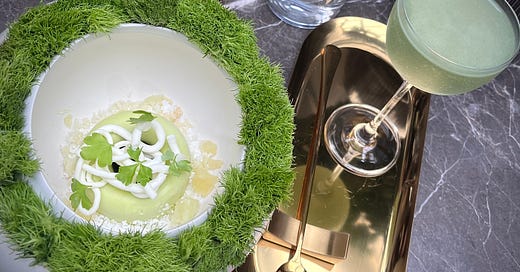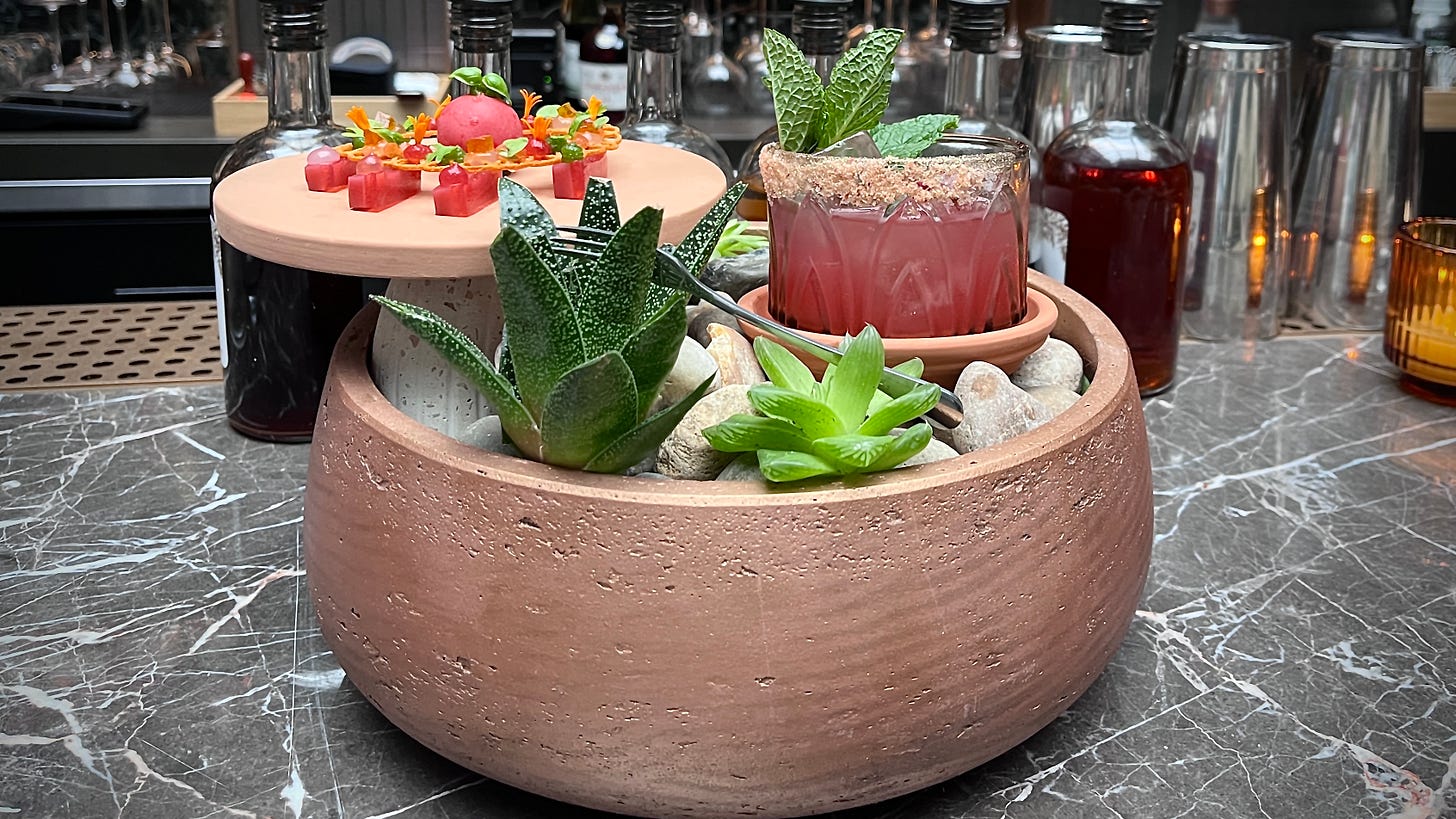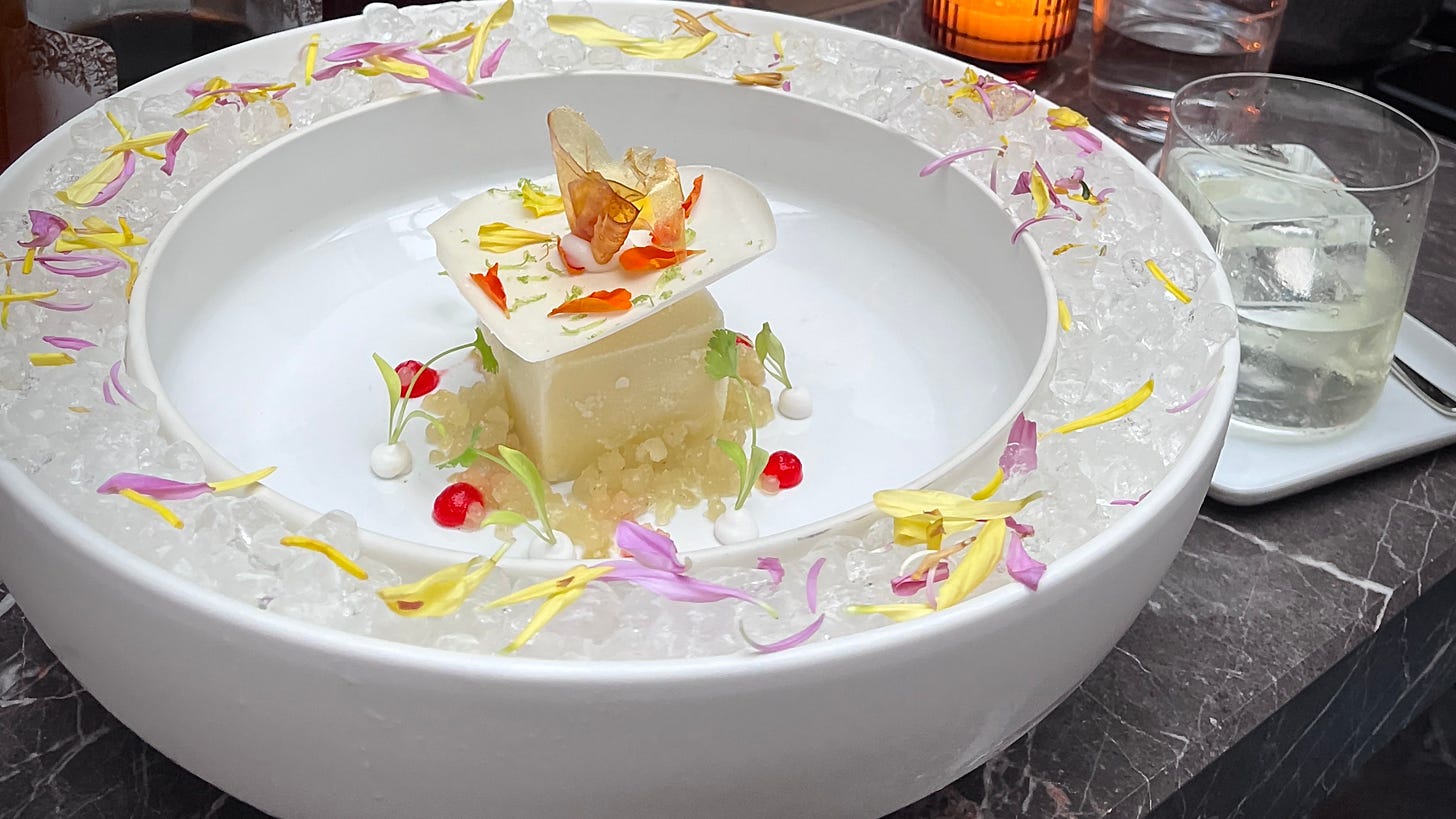I Have Extremely Mixed Feelings about BarChef New York
I took a first look at the new bar—and ate a $43 cocktail so you don’t have to.
The clues had been building for a while, during BarChef New York’s months-long pre-opening promotional blitz via Instagram, that perhaps I wasn’t the cocktail bar’s target audience.
First, there were the slick videos, shot Chef’s Table-style, highlighting creations clearly meant to be appreciated as much with the eyes, or perhaps the iPhones, as with the palate. A garden of eucalyptus surrounds an illuminated glass, the vessel’s contents (gels, various ices, microgreens) carefully tweezered in. A wreath of flowers envelops a glass holding nothing but a pink ice sphere and a dollop of foam. Liquid nitrogen is applied in a variety of ways to a variety of substances before they’re all carefully placed together in a large bowl. (Are these cocktails? Are they meant to be consumed in liquid form? The answers, respectively, are yes, and sometimes, apparently.)
Then there was the bar’s location: on 35th Street, just off Herald Square, on the third floor of a new dining destination, above a sleek Korean steakhouse and a Wagyu-focused joint—perhaps a signal as to which sort of crowd the bar is actually hoping to draw in. (CoughFinanceBrosCough.)
The nail in the coffin was the promoted collaboration with model and Kardashian sister Kendall Jenner’s 818 tequila, notorious for its overly vanilla-y, birthday-cake-like flavor, presumably imparted by a large quantity of additives. This is a tequila wildly popular among the sort of folks who idolize the Kardashians, but it’s unanimously despised by serious drinks people.
And yet. This is not some small-time bartender we’re talking about. I’ve been to BarChef’s original location in Toronto and enjoyed it; it’s a solid and well-respected cocktail bar. Frankie Solarik, the big name behind the BarChef brand, was bar legend Julie Reiner’s fellow judge on the Netflix cocktail competition series Drink Masters.
And New York City hasn’t seen anything quite like the creations the bar seemed to be offering.
So I figured that the New York City branch of BarChef, which technically opened yesterday but has been in soft-opening mode since last Thursday, would be worth checking out.
Let me first tell you about BarChef’s space. It’s perhaps the single most impressive aspect of the entire venture. Once you ascend to the third floor of the building via rainbow-lighted stairs, you enter an airy room with a high glass ceiling: It’s a retractable roof that, on a non-drizzly evening (perhaps we’ll eventually get one of those in NYC this summer) would provide a worm’s-eye view of the Empire State Building. It’s remarkable. Honestly, it’s glorious.
There are two separate bars, one at each end of the long, narrow space. One handles the complicated “Modernist” creations (more on the distinction in a moment); the other is where the more standard “Contemporary” cocktails are made. My companion and I had been led to seats at this latter bar. Low-slung tables and banquette seating lined the wall opposite. To be honest, I didn’t spend too much time looking around the space. Why would you, when you can look up? Or when the concoctions placed in front of you demand so much attention?
Now, about those cocktails. The first and most important thing to know is that the menu is divided into two sections: “Contemporary” and “Modernist.”
The “Contemporary” section comprises liquid offerings that all conform to what you and I might think of as “cocktails.” There are fifteen of them over two menu pages, all priced between 23 and 25 dollars. I tried three from this section. None truly knocked my socks off, but they were all pretty good. I would order any of them again, if somebody else were paying, and would happily keep exploring this section of the menu.
That’s not the section you want to know about, though.
The “Modernist Series” is the section where you’ll find the complicated creations I can’t bring myself to call “cocktails,” eight in total. Most of them, but not all, are in fact accompanied by a typical cocktail, generally a variation on a well-known classic.
My drinking companion selected the Jardin de Monet as our first choice from this section. (Price: $38. Ingredients list, as given on the menu: Hand-foraged spruce-infused London dry gin, clarified grapefruit, Strega, maraschino, chlorophyll, dill bitters, kiwi & white wine cordial, cucumber, orange blossom & citrus carbonic snow, parsley & green chartreuse semifreddo, citrus cells, elderflower gel, micro celery greens, mandarin cream tendril.)
At least the first five, and perhaps the first seven or eight, ingredients listed were incorporated into an actual liquid cocktail served, ungarnished, in a Nick & Nora to the side of the main attraction. It was a Last Word riff; I confess I might not have guessed it from the list of ingredients, but it became obvious upon taking a sip. It was pretty delicious.
And then the liquid broke shortly after being placed in front of us, its ingredients spontaneously separating in a way I’m not sure I’ve seen happen in a cocktail before.
The drink had been served alongside a massive white bowl, ringed with grassy tufts, that contained a riot of spring green, lemon yellow, and white, all in gel or solid, frozen form. The semifreddo was in a donutlike shape, encircling a dark green substance that was perhaps the parsley element. It sat on a base of “snow” and yellow bits that I suppose were the “citrus cells.” A white noodle (the mandarin cream tendril?) had been squiggled amorphously on top of it all, the celery greens held on by small blobs of—I checked the menu—what must be the elderflower gel.
It looked like the sort of dessert you’re served in a tertiary-city restaurant that wants to believe it’s the next Alinea. It looked kind of messy, frankly.
My companion assembled for me a “perfect bite” of the solid/frozen components, containing a bit of every element, on the provided gold parfait spoon. I took it. The icy elements quickly melted and combined on my tongue, producing a flavor that was sweet and herbaceous and lightly acidic, but not in a way that seemed intentional or even coherent. I was left with a gloppy noodle-like thing on my palate, plus a long string of a slightly slimy vegetable.
It was an experience I did not care to repeat. I picked at individual elements with the long golden spoon to ingest separately from that point on.
For our second Modernist creation, I chose the Rose Gold Margarita. (Price: $38. Ingredients: Pequin-pepper-infused Patron reposado, roasted agave, lime leaf-infused Lillet, hibiscus-infused Campari, fresh lime, coconut, green cardamom, saffron, smoked floral tuille, rose-gold salt rim, white chocolate encapsulation of spiced citrus.)
It was delivered via an enormously heavy terracotta pot filled with rocks and topped with three small succulents of types that sit on my own windowsill that had been stripped of their roots (the fate of which I fretted over; it seems terribly wasteful to kill dozens of succulents per service).
The margarita—liquid—was a vivid pink, served on the rocks with a half-rim of pink salt and gold glitter and garnished with a sprig of mint. Beside the drink, on a shelf, sat a circular tuille adorned with tiny dots of gel, each dot smaller than a pencil eraser, in four flavors, repeating. They immediately started melting through the tuille, which was elevated on small bricks of agar-agar-solidified hibiscus and Campari. The ring of tuille and gels encircled a bite-size hollow ball of white chocolate, which contained a spicy citrusy liquid.
I was instructed, first by the server and then by the bartender, to start by eating the white chocolate thing, then take a sip of cocktail, then try each gel sequentially, following each taste with a sip of cocktail. It was, admittedly, fun to receive explicit permission to play with my food. It was considerably less fun to be instructed on precisely how to do so, the implication being that any other way was wrong, that any undesired results after not following the instructions would be my own fault. The tuille broke apart at the touch of a fork in the messiest way, spilling onto my phone next to the terracotta planter and covering its screen in gel residue.
The bigger problem, for me, was that while the cocktail was perfectly tasty (if relatively unremarkable), its aromatics so strongly resembled rank male summer body odor (think someone’s raised arm on the subway during an August rush hour) that I had to hold my breath each time I went in for a sip.
We debated over our third and final choice from the Modernist section. Earlier in the evening, the bartender had called our attention to one creation in particular, the Abstract Ice ($34; ingredients list: London dry gin, maraschino, elderflower soda, violette, black licorice, micro basil, rhubarb ice, lemon & chamomile gel, violette & orgeat gel, elderflower carbonic snow, cucumber ice shards, tarragon), which, he said, involves no liquid-state ingredients at all. It’s an entirely “deconstructed” “cocktail,” its elements each presented separately. You can eat them while they’re still frozen, the bartender had told us, or allow them to melt and combine into a liquid cocktail. “It’s sort of a choose-your-own-adventure situation,” he said.
“How would that work?” I asked. If someone eats part or all of an element, wouldn’t the melted resulting cocktail then be unbalanced or obviously lacking something?
Definitely not, I had been assured. “It’s designed in such a way that any reduced or absent ingredients wouldn’t really detract from the drink.” Huh.
We opted instead for the Piña Colada (coconut-washed and clarified; coconut disk, pineapple and cedar sherbet, roasted pineapple paper, pineapple and ginger ice gel drops, micro coriander, maraschino and rose, lime cells), as our third selection from the Modernist menu, partly because, as I’ve previously noted, you can never go too wrong with a piña colada, but also largely out of curiosity. It was one of the two most expensive creations offered, at $43. What, we wondered, could possibly make a piña colada worth $43?
I’m afraid I do not have an answer for you.
Visually, we were at least up to fine-dining level with this creation. The piña colada itself comes clarified and served down over a large rock. It was entirely drinkable; I might have been more impressed with it if I hadn’t also recently encountered several examples of similar cocktails (the Martiña Colada at Tallboy, a clarified mai tai at True Laurel, a clarified jungle bird at Zombie Village) in a mere two-week span in San Francisco. But even if not particularly impressive, it was entirely enjoyable.
The accompanying spectacle arrived in a massive white bowl, its rim encircled with pebble ice and flower petals. The largest component in that bowl was a cube of compressed pineapple-and-cedar sorbet, seemingly the exact size and shape of the large rock in the piña colada glass. The coconut disc and pineapple “paper” sat atop it, along with some flower petals (nasturtiums?); the gel drops and lime “cells” surrounded it in the bowl.
Like the cocktail, it was all fine, but I would declare it much more appealing visually than flavor-wise. It all seemed so, well, unnecessary. I wouldn’t say that it enhanced the cocktail in any way, it just kind of vaguely echoed it in photogenic form. If I’d ordered the dish separately, elsewhere, as a dessert at a fine-dining restaurant, I probably would have taken a photograph of it and then, after an initial taste, would have shrugged and said “Yeah, sure, it’s fine.”
Between our second and third rounds, we had been brought a belated amuse bouche of sorts, a couple of bites sent out by the chef, small pink mounds sprinkled with lime zest, sitting atop a bed of dried rosebuds. They seemed to be meringues, but nitro-frozen rather than oven-baked. They were still smoking from their liquid nitrogen treatment.
I gave it a few moments, then picked one up and placed it on my tongue—and yanked it right back off: It had burned me. (I could still feel it a couple hours later, but was fine by the next morning.) It made me glad I hadn’t ordered any of the concoctions streaming dry ice vapors I’d seen being served to other guests. The irony: Hadn’t alt-ice safety been addressed in the very first episode of Drink Masters by Solarik himself?
Speaking of Drink Masters: At a certain level, any disappointment in the experience at BarChef is on me. In retrospect, I perhaps should have anticipated all of this.
Putting aside my prior visit to the original Toronto location (which was a relatively good experience and also where, at the time I visited, there was much less of an emphasis on absurd ice-based creations), I, like most cocktail-loving folks, was first introduced to Solarik on Drink Masters.
I went back and rewatched that first episode. In it, Solarik says (just prior to tasting the competitors’ first cocktails): “I don’t want to just drink a cocktail out of a glass. I want some edible components. I want something visual, aromatic as well, a full sensorial experience.”
He seemed to have been brought onto the show to be the judge who consistently (perhaps over)prioritizes the telegenic aspects of cocktails—their presentation, the story behind their creation—since that’s what translates via TV, a medium through which viewers cannot judge a drink’s flavor and so have to evaluate it from afar by other means.
Solarik, on Drink Masters as well as in these modernist creations, clearly puts the highest emphases on appearance and on storytelling. I’m a drinks journalist who enjoys taking photos—a storyteller and a photographer—so both elements are somewhat important to me. But above all, what matters most to me in a drink is: Is it delicious?
It’s all confusing to me. Clearly the BarChef team knows how to work with flavors, as evidenced by the perfectly delicious “contemporary” cocktails I tried.
But BarChef is perhaps being treated similarly to a television show: It seems to be a made-for-social media spot, along the lines of Bad Roman, the Italianish restaurant people love to hate but is constantly packed full of influencers. Flavor and texture can’t be transmitted via TikTok, but spectacle sure plays well.
Our bartender had mentioned, in passing, a “media night” happening the following evening. (I hadn’t been invited; he had no reason to think I might have been). I kept an eye on the bar’s social media out of curiosity. Every attendee-created piece of media the bar reposted to its Instagram stories within 24 hours of the event was by self-proclaimed “digital creators” with high follower counts and suspiciously low engagement. (For instance, one “influencer” had 355K followers, yet every grid post of hers I clicked on had less than 100 likes.)
Influencers, whether real or aspiring, will indeed love this place, taking their videos of the dry ice billowing from an elaborate presentation. As will the expense-account bros who’ll dine at the wagyu joint and continue on to the bar for after-dinner drinks meant to impress. So will wealthy out-of-town visitors who will splash out a lot of cash to enjoy up-close views of the city’s most famous building.
But for those of us who just want to drink a delicious cocktail and don’t need it to be accompanied by spectacle? Look, I realize you’re probably going to go there anyway to check out those Chef’s Table-style concoctions firsthand for curiosity’s and social media’s sake and to gaze upward at the Empire State Building and marvel at the view. I’m not going to tell you that you shouldn’t.
I just think you may want to brace yourself to not be impressed in the way the internet may have led you to expect.
BarChef seems to actually be two bars in one: one bar (or, at least, one menu) for people who actually want to enjoy a drink, and the other for people who want to order, video, and post to social about a visually spectacular creation.
Put another way: one bar (or menu) for people who want to be impressed by the bar and the things it creates, and a separate one for those who want to impress others with their presence at the bar and the things it creates.






Hehehe “ate”. This trend needs to choke on its own oil slick.
I really was entertained by BarChef in Toronto. So I was hoping it would be the same. But the thought of a sensorial experience associated with a drink that delivers “aromatics so strongly resembled rank male summer body odor” inspires avoidance, as Herald Square usually does. Thank you for your service, as always!